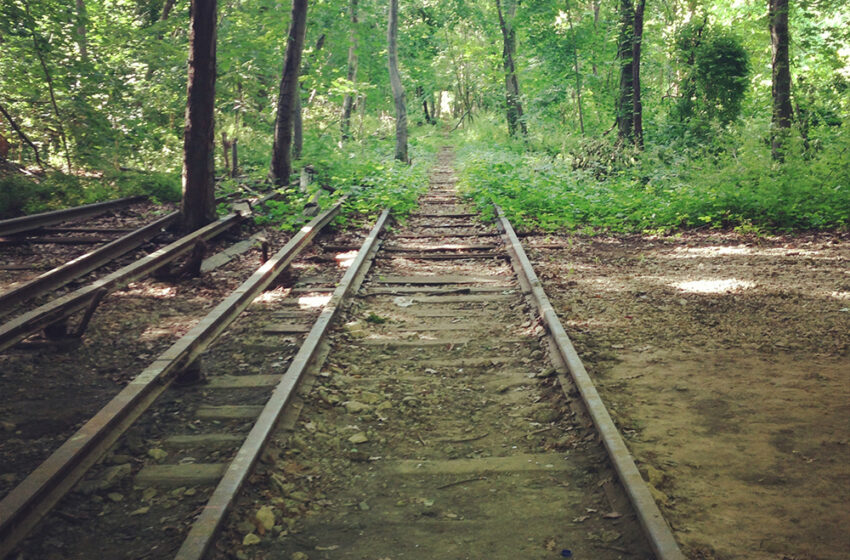QueensLink: A Struggle for Rails to Rockaway

The dilapidated Rockaway Beach Branch that once serviced the LIRR.
By Lucas Battista
As of the last month, Mayor Eric Adams has announced the reception of a $117 million grant from the federal government, specifically the Department of Transportation, for the construction of a 3.5 mile “high-line-esque” park. It would mark the seemingly final blow in a quiet, ongoing battle between two starkly contrasted initiatives, Queensway and QueensLink, both of which propose to repurpose the former Rockaway Beach line for entirely different uses.
Queensway seeks to transform it into a park, whereas QueensLink has put forward a proposition for its reactivation, connecting the Rockaways to the M-Line, and by proxy the LIRR. Despite a five-year long campaign consisting of a 15,000-signature petition, various studies, public endorsements from a plethora of local elected officials, canvassing, and general public approval, it seems that QueensLink’s efforts have fallen on the mayor’s deaf ears. It is important to note that the fusion of both a park and rail-line was not off the table, but by first constructing a park any future connection to Queens would be entirely impeded. Nevertheless, QueensLink has continued to fight by pushing for a $10 million Environmental Impact Statement (EIS) to be tacked onto it.

The Rockaways have struggled with economic isolation and bad weather for about as long as people first settled here some two centuries ago, and only at the advent of modern transportation and infrastructure have we begun to crawl out of the sand bar. At around the turn of the century, the Rockaway peninsula reached its peak as a kind of second Coney Island, with at one point serving as the home to the 1,184-foot monolithic Rockaway Beach Hotel. (So big, in fact, it would be demolished six months later!) By the completion of Jones Beach at the behest of Robert Moses in 1929, the Rockaways began to lose their prime source of revenue: beachgoers. The peninsula itself would become peppered by derelict bungalows and amusement rides, before the further construction of the Marine Parkway Bridge and Cross Bay Veterans Bridge in 1937 and 1939 respectively. Despite suffering from economic downturn, the two bridges would enable the Rockaways to transform into a “full-time” community, allowing for commuters that at one time were only able to reach the City from its sole train station. In 1962, the LIRR’s Rockaway Beach Branch was deactivated due to maintenance costs and increasing use of cars among residents. There have been numerous attempts pushing for its reactivation and repurposing for decades, culminating in a struggle that has gone on for 60 years.
QueensLink itself began as QueensRail Corp, a nonprofit 501(c)(3) established in 2016 by the Queens Public Transit Committee, with the mission statement of “Improving public transit and open space in Central and South Queens,” according to their website, thequeenslink.org. As of the last eight years, it has towed the same line, with the revision of supporting both “rails and trails,” in contrast to a debate in May 2017 in the Queens Chamber of Commerce concluding that the rail-line and park are incompatible, according to a 2017 article by the Brooklyn Downtown Star. The organization more recently reached out to blogger and cartographer Andrew Lynch, who would visually render an integration of parks and rails side by side. With its current proposal, according to a study QueensLink contracted through Transportation Economic Management Systems Inc. (TEMS), it has touted benefits including but not limited to, a $50 to $70 billion increase in property development, $9 to $13 billion dollar increase in income per year, the addition of 100,000 to 150,000 jobs, a 15-minute reduction in travel time from Howard Beach to Manhattan, reduced admissions, accidents, and auto-congestion. As of the last two decades, the Rockaways have already received significant attention from developers and fledgling businesses, with a population that has, indicated by the census, increased by eight percent in the last 10 years. At such a rate that it is considered the fourth fastest growing neighborhood within Queens, and higher than the average of Queens itself and city-wide. A 2022 study from the Office of the State Comptroller has indicated that in the last twenty years, the Rockaways’ businesses have grown by 55.8 percent, income has increased by 32% more than in 2006 to 2010. And yet despite all of this, the Rockaways still objectively have the longest commute time of any neighborhood in the city.
Furthermore, disaster-response and the reaction to the pandemic was disastrous, with Far Rockaway holding the second highest deathrate of any area within Queens. Were a future disaster to occur, it is projected that, according to Community Resilience Estimates (CREs) from the U.S. Census Bureau, “more than one-half of Arverne and Far Rockaway residents were at medium risk of experiencing disaster in an emergency event,” and “more than two-fifths of Edgemere residents, as well as some residents in parts of Rockaway Park and Hammels, were categorized as high risk.” It is evident that all of these issues could be mitigated or prevented entirely if better transportation-infrastructure implemented.
What does this entail for the Rockaways?
If QueensLink succeeds in lobbying for a “Queens-connection,” it would finally allow for the Rockaway peninsula as a whole to break the last lock from the coffin on its greatest issue: isolation. Plenty of low-income communities here have suffered extensively from our transportation-desert and lack of rail connection that any other section of Queens couldn’t exist without and would pave the way for a massive economic vitalization that it came so close to before Hurricane Sandy and COVID-19. It is a critical moment in deciding a prosperous future for a neighborhood that’s survived the ravaging of hurricanes, economic-downturn, and Robert Moses’ failed projects. To many, it seems that in an hour of adversity, the Rockaways cannot be cheated of a project with potential this great.
Interested in contacting QueensLink? Reach them at thequeenslink.org


